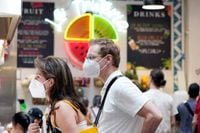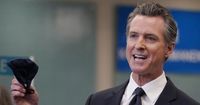California finds itself once again at the epicenter of the COVID-19 conversation as a late-summer wave of infections sweeps across the state. Driven by a sharp uptick in positive test rates and hospital admissions, coupled with high levels of coronavirus detected in wastewater, public health officials are urging residents to dust off their masks and reconsider pandemic-era precautions—at least for now. This comes as the Golden State, alongside Oregon and Washington, launches a new regional health alliance in opposition to recent federal vaccine policy changes, signaling a broader debate over science, politics, and public trust.
According to the Centers for Disease Control and Prevention (CDC), coronavirus infections are either "growing" or "likely growing" in 30 states, including California. Wastewater surveillance—a tool that’s proved invaluable since the pandemic’s onset—has revealed that California currently boasts some of the nation’s highest levels of SARS-CoV-2 in sewage. As Matt Willis, former Marin County health officer, explained to Straight Arrow News, "Wastewater has been a great breakthrough for us in public health surveillance since the start of the pandemic. It’s really the best way to see how active the virus is in a given community."
While the current concentrations are still about 20 percent lower than the peak from the 2023 summer wave and roughly 50 percent lower than the 2024 summer peak, the climb is unmistakable. The California Department of Public Health told Straight Arrow News, “Overall wastewater concentrations of SARS-CoV-2 are currently increasing, and it is not yet clear when wastewater activity will peak this summer.”
It’s not just the sewage data that’s raising eyebrows. For the week ending August 23, 2025, a striking 12.07% of COVID-19 tests statewide came back positive—double the rate from late July. Los Angeles County saw its positivity rate jump from 8.11% to 13.44% over the same period, while Orange County’s rate soared from 9.4% to 18.1%. Even San Francisco, typically more insulated, saw an increase from 7.1% to 8.7%. The CDC’s epidemic trend for California is now officially labeled as "likely growing."
Hospital admissions, though still considered low, are inching upward. For the week ending August 23, California reported 3.6 COVID-19 hospital admissions per 100,000 people, up by 0.5 from the previous week. Thankfully, deaths from the virus remain very low, a testament to both natural immunity and the impact of vaccinations. “We’ve obviously come a long way since 2020. Even in my community, in Marin County where I was health officer, we were seeing dozens of deaths every month. It’s been a while since we’ve seen any in our community,” Willis reflected to Straight Arrow News. “At the same time, we’re still seeing people coming into the hospital. We’re still seeing emergency room visits increasing for our youngest residents, so it’s still a threat to us.”
Another wrinkle in the current wave is the emergence of the XFG or “Stratus” variant, now the dominant strain in California. While experts like Willis caution that most new variants don’t necessarily spell disaster, he emphasized the importance of continued molecular testing to spot any that might cause more severe illness or spread more easily.
Given these trends, county-level health officials are once again recommending that Californians mask up indoors—especially in areas with high transmission. Dr. Aimee Sisson, Yolo County Health Officer, was unequivocal in her advice: “California is experiencing a summer COVID wave. Based on current wastewater levels of the virus that causes COVID-19, I recommend that everybody in West Sacramento wear a mask when they are around others in indoor public spaces. I also recommend that people in the rest of Yolo County wear masks when they are around others indoors if they are 65 or older, have a weakened immune system, have an underlying medical condition that puts them at a greater risk of severe COVID-19, or spend time around people who fall into these categories.” For added protection, she said, “Wearing a high-quality mask such as an N95, KN95, or KF94 that fits well continues to provide strong protection.”
Masking, once a flashpoint in America’s culture wars, remains a personal choice for many, but the science is clear. “The fact is that as a tool, a mask is an effective way of preventing infection, period,” Willis told Straight Arrow News.
Vaccination remains another crucial line of defense. “High vaccination rates translate to lower mortality at the community level, and for an individual, it’s the same,” Willis said. “If you’re vaccinated, you’re much less likely to end up in a hospital and that’s just been proven over and over again. That is not a political statement. That is just a scientific reality.” Dr. Sisson echoed this sentiment, telling The Los Angeles Times, “Vaccination remains one of the most effective ways to prevent severe disease and death from COVID-19.”
Yet the vaccine landscape has shifted dramatically in recent weeks. Under Health and Human Services Secretary Robert F. Kennedy Jr., the Food and Drug Administration announced that only people aged 65 or older, or those with certain medical conditions, are eligible for the newest COVID-19 shots. The general public and children under five are not included, and those seeking vaccines must now go through their doctor rather than booking directly with a pharmacy.
This federal policy change has prompted swift pushback from the West Coast. On September 3, Governor Gavin Newsom announced the formation of the "West Coast Health Alliance" with Oregon and Washington. The alliance aims to develop its own vaccine guidelines, a move reminiscent of the "Western States Workgroup" Newsom established in October 2020. “The CDC has become a political tool that increasingly peddles ideology instead of science, ideology that will lead to severe health consequences,” Newsom declared in a statement reported by the Daily Mail. “California, Oregon, and Washington will not allow the people of our states to be put at risk.”
The federal Department of Health and Human Services fired back, accusing the alliance of politicizing health policy. Agency spokesman Andrew G. Nixon told the Daily Mail that “Democrat-run states that pushed unscientific school lockdowns, toddler mask mandates, and draconian vaccine passports during the COVID era completely eroded the American people’s trust in public health agencies.” He added that the Advisory Committee on Immunization Practices “remains the scientific body guiding immunization recommendations in this country, and HHS will ensure policy is based on rigorous evidence and Gold Standard Science, not the failed politics of the pandemic.”
As the debate over science and politics plays out in headlines, Californians are left to navigate a familiar but fraught landscape: rising cases, renewed mask recommendations, and shifting vaccine policies. For now, the numbers—and the experts—suggest caution is warranted, but not panic. With a new alliance taking shape and the virus continuing to evolve, the state’s response in the coming weeks may set the tone for the rest of the nation.

